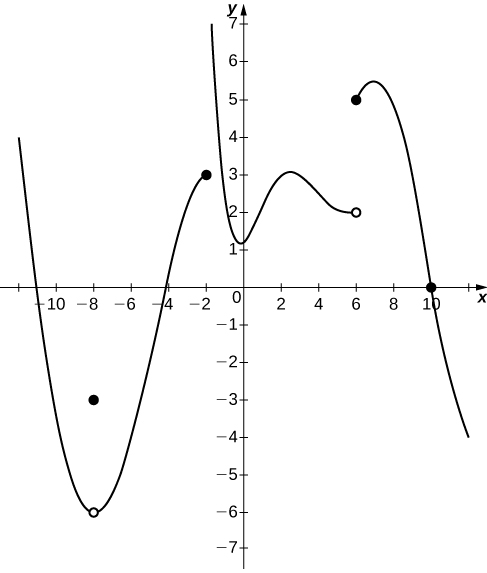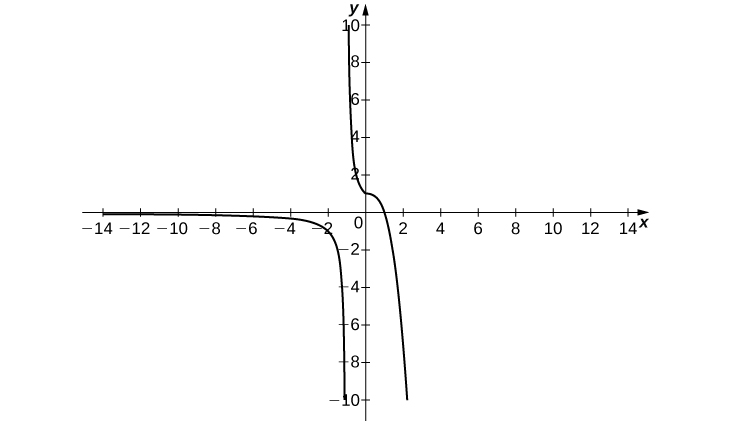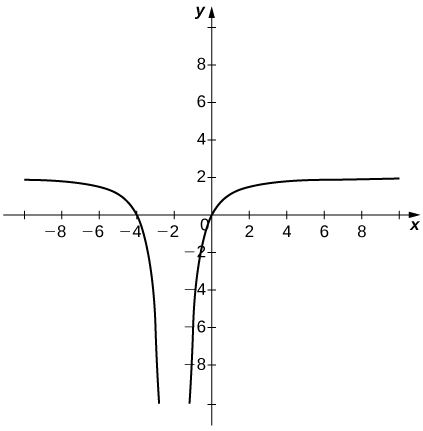2.3E: Exercises for Section 2.3
- Page ID
- 48929
Infinite Limits
[T] In exercises 1 - 2, set up a table of values to find the indicated limit. Round to eight significant digits.
1) \(\displaystyle \lim_{z \to 0}\frac{z−1}{z^2(z+3)}\)
| \(z\) | \(\frac{z−1}{z^2(z+3)}\) | \(z\) | \(\frac{z−1}{z^2(z+3)}\) |
|---|---|---|---|
| -0.1 | a. | 0.1 | e. |
| -0.01 | b. | 0.01 | f. |
| -0.001 | c. | 0.001 | g. |
| -0.0001 | d. | 0.0001 | h. |
- Answer:
- a. −37.931034; b. −3377.9264; c. −333,777.93; d. −33,337,778; e. −29.032258; f. −3289.0365; g. −332,889.04; h. −33,328,889
\( \displaystyle \lim_{x \to 0}\frac{z−1}{z^2(z+3)}=−∞\)
2) \(\displaystyle \lim_{t \to 0^+}\frac{\cos t}{t}\)
| \(t\) | \(\frac{\cos t}{t}\) |
|---|---|
| 0.1 | a. |
| 0.01 | b. |
| 0.001 | c. |
| 0.0001 | d. |
[T] In exercises 3 - 4, set up a table of values and round to eight significant digits. Based on the table of values, make a guess about what the limit is. Then, use a calculator to graph the function and determine the limit. Was the conjecture correct? If not, why does the method of tables fail?
3) \(\displaystyle \lim_{α \to 0^+} \frac{1}{α}\cos\left(\frac{π}{α}\right)\)
| \(a\) | \(\frac{1}{α}\cos\left(\frac{π}{α}\right)\) |
|---|---|
| 0.1 | a. |
| 0.01 | b. |
| 0.001 | c. |
| 0.0001 | d. |
- Answer:
-
a. 10.00000; b. 100.00000; c. 1000.0000; d. 10,000.000;
Guess: \(\displaystyle \lim_{α→0^+}\frac{1}{α}\cos\left(\frac{π}{α}\right)=∞\);
Actual: DNE, since the graph shows the function oscillates wildly between values approaching positive infinity and values approaching negative infinity, as the value of \(α\) approaches \(0\) from the positive side.![A graph of the function (1/alpha) * cos (pi / alpha), which oscillates gently until the interval [-.2, .2], where it oscillates rapidly, going to infinity and negative infinity as it approaches the y axis.](https://math.libretexts.org/@api/deki/files/1863/CNX_Calc_Figure_02_02_214.jpeg?revision=1&size=bestfit&width=417&height=348)
4) \(\displaystyle \lim_{θ \to 0}\sin\left(\frac{π}{θ}\right)\)
| \(θ\) | \(\sin\left(\frac{π}{θ}\right)\) | \(θ\) | \(\sin\left(\frac{π}{θ}\right)\) |
|---|---|---|---|
| -0.1 | a. | 0.1 | e. |
| -0.01 | b. | 0.01 | f. |
| -0.001 | c. | 0.001 | g. |
| -0.0001 | d. | 0.0001 | h. |
In exercises 5 - 8, consider the graph of the function \(y=f(x)\) shown here. Which of the statements about \(y=f(x)\) are true and which are false? Explain why a statement is false.

5) \(\displaystyle \lim_{x→−2^+}f(x)=3\)
- Answer:
- False; \(\displaystyle \lim_{x→−2^+}f(x)=+∞\)
6) \(\displaystyle \lim_{x→−8}f(x)=f(−8)\)
7) \(\displaystyle \lim_{x→6}f(x)=5\)
- Answer:
- False; \(\displaystyle \lim_{x→6}f(x)\) DNE since \(\displaystyle \lim_{x→6^−}f(x)=2\) and \(\displaystyle \lim_{x→6^+}f(x)=5\).
8) \(\displaystyle \lim_{x→10}f(x)=0\)
In each exercise, sketch the graph of a function with the given properties.
9) \(\displaystyle \lim_{x→−∞}f(x)=0, \quad \lim_{x→−1^−}f(x)=−∞, \quad \lim_{x→−1^+}f(x)=∞,\quad \lim_{x→0}f(x)=f(0), \quad f(0)=1, \quad \lim_{x→∞}f(x)=−∞\)
- Answer:
-
Answers may vary

10) \(\displaystyle \lim_{x→2}f(x)=1, \quad \lim_{x→4^−}f(x)=3, \quad \lim_{x→4^+}f(x)=6, \quad x=4\) is not defined.
11) \(\displaystyle \lim_{x→−∞}f(x)=2,\quad \lim_{x→−2}f(x)=−∞,\quad \lim_{x→∞}f(x)=2,\quad f(0)=0\)
- Answer:
-
Answer may vary

12) \(\displaystyle \lim_{x→−∞}f(x)=2, \quad \lim_{x→3^−}f(x)=−∞, \quad \lim_{x→3^+}f(x)=∞, \quad \lim_{x→∞}f(x)=2, \quad f(0)=-\frac{1}{3}\)
13) \(\displaystyle \lim_{x→−∞}f(x)=0,\quad \lim_{x→−1^−}f(x)=∞,\quad \lim_{x→−1^+}f(x)=−∞, \quad f(0)=−1, \quad \lim_{x→1^−}f(x)=−∞, \quad \lim_{x→1^+}f(x)=∞, \quad \lim_{x→∞}f(x)=0\)
Contributors and Attributions
Gilbert Strang (MIT) and Edwin “Jed” Herman (Harvey Mudd) with many contributing authors. This content by OpenStax is licensed with a CC-BY-SA-NC 4.0 license. Download for free at http://cnx.org.


